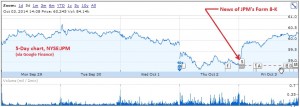Mapping Treasure: Looking Beyond the Yield of Traditional Insider Trading
A fresh spin on insider trading also made news this week, when the SEC filed a lawsuit against two Capital One fraud investigators who made 1800 percent on their investment over three years, based on their use of a Capital One credit card user database.
The two investigators, Bonan Huang and Nan Huang, grew an investment of $147,300 to $2.8 million based on thousands of searches across a database comprised of credit card customer transactions. Noting the volume of use of credit cards at a particular fast food company, they bought and traded the company’s stock based on this data.
Over time they made similar stock trades based on transactional volume and other publicly available news about three different companies.
Had the database been one for sale by a company rather than their employer’s proprietary database, the Huangs would have been lauded as investment rock stars. But because the method they used “misappropriates confidential information for securities trading purposes, in breach of a duty owed to the source of the information,” the two men are being sued for insider trading.
The Huangs’ trading experience gives pause when one considers the value of metadata, and of the data breach at JP Morgan Chase this past year.
Metadata can offer a volume of transactional activity, though it will not disclose the value of a transaction. Imagine smartphones indicating they are being used at particular devices – point-of-sale devices – at any retailer, from fast food to hard lines. An uptick in overall activity at a specific retailer indicates greater volume of business, the data fresher than that reported in a 10-Q report filed publicly with the SEC. What could an investor do with this kind of data? One could imagine success not much different than the Huangs experienced, provided they also understood other publicly available information about the retailers under observation. Read more →


